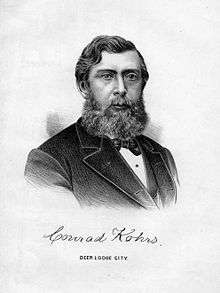Nathaniel P. Langford
| Nathaniel P. Langford | |
|---|---|
|
1870 Portrait of Nathaniel P. Langford | |
| Born |
1832 New York City |
| Died |
1911 Minnesota |
| Occupation | Park superintendent, Vigilante, Historian |
Nathaniel Pitt Langford (1832–1911) was an explorer, businessman, bureaucrat, vigilante and historian from Saint Paul, Minnesota who played an important role in the early years of the Montana gold fields, territorial government and the creation of Yellowstone National Park.[1]
Early life
Langford was born in Upstate New York and moved to Saint Paul in 1854. He worked as a banker was involved with the investment of the Saint Anthony Park neighborhood.[2]
Montana Gold Fields
On June 16, 1862 Langford, as a member and officer of the Northern Overland Expedition, commanded by Captain James L. Fisk, left Saint Paul to establish a wagon road to the Salmon river mine regions of the Rocky Mountains via Fort Benton.[1][3] The expedition ended up at the Grasshopper Creek gold fields in the area soon to be named Bannack, Montana. There Langford and his fellow businessmen established freight companies, a saw mill and other businesses.
Vigilante
Langford was also part of the vigilante movement, the infamous Montana Vigilantes, that dealt with lawlessness in Virginia City and Bannack, Montana during 1863-64.[1]
In 1890, Langford wrote Vigilante Days and Ways to chronicle the era of pioneer justice in the American Old West.[4]
Territorial Tax Collector
In 1864, shortly after the Montana Territory was established on May 28, 1864, Langford was appointed Collector of Internal Revenue and National Bank Examiner, positions he held for five years in the Montana Territorial government.[5]
Yellowstone Exploration and Creation
Langford was a member of the 1870 Washburn–Langford–Doane Expedition which explored portions of the region that soon would become the Yellowstone National Park.[6] Mount Langford, 10,623 feet (3,238 m) in the Absaroka Range, 7.5 miles (12.1 km) east of Yellowstone Lake, was scaled by Langford and Doane during the expedition and named after him.[7]
After his participation in the Washburn expedition, Langford was appointed as the first superintendent of the park. He soon got the nickname National Park Langford because of his initials N.P. There was no money available to offer him a salary for this new position, so he had to make his living elsewhere. This left Langford with little time to run the park, and he entered it only twice during his five years as superintendent. The first time was as a guest on the second Hayden Expedition in 1872, and his second took place in 1874 to evict a man named Matthew McGuirk. McGuirk claimed to own the Boiling River - one of the park's hot springs rumored to have healing powers.
Langford had no salary, no funding for the park, and no legal way to enforce protection for its wildlife and geologic features. Political pressure, which took the guise of accusing Langford of neglect, forced the removal of Yellowstone's first superintendent in 1877. He was replaced by Philetus W. Norris. In 1905, Langford published Diary of the Washburn Expedition to the Yellowstone and Firehole In the Year 1870 as a comprehensive insider's view of the expedition.
Historian
After his Yellowstone experiences, Langford returned to his home state of Minnesota and began a career as a Western historian. Prior to his passing he served as the President of and on the Board of Directors of the Minnesota Historical Society.
Notes
- 1 2 3 Nathaniel Pitt Langford, The Vigilante, the Explorer, the Expounder and First Superintendent of Yellowstone Park, Olin D. Wheeler, Speech to the Montana Historical Society, April 8, 1912
- ↑ Empson, Donald L. (2006). The Street Where You Live. Minneapolis, Minnesota: University of Minnesota Press. p. 159. ISBN 978-0-8166-4729-3.
- ↑ Chittenden, Hiram M. (1903). History of Early Steamboat Navigation on the Missouri River. New York: Francis P. Harper. p. 270.
- ↑ Langford, Nathaniel Pitt (1890). Vigilante Days and Ways-Pioneers of the Rockies-The Makers and Making of Montana, Idaho, Oregon, Washington and Wyoming. New York: D. D. Merrill Company.
- ↑ Johnson, Dorothy M. (1971). The Bloody Bozeman-The Perilous Trail To Montana's Gold. New York: McGraw Hill Book Company.
- 1 2 3 Langford, Nathaniel Piit (1905). The Discovery of Yellowstone Park--Diary of the Washburn Expedition to the Yellowstone and Firehole Rivers in the Year 1870. St Paul, MN: Frank Jay Haynes.
- ↑ Chittenden, Hiram Martin (1918). The Yellowstone Park-Historical and Descriptive. Cincinnati, OH: Stewart and Kidd Company Publishers. pp. 67, 97.
References
Further reading
Correspondence, diaries, genealogical data, clippings, and other papers relating to Nathaniel Pitt Langford and his family are available for research use: Nathinal Pitt Langford and Family: An Inventory of Their Papers. Included is data regarding the family's life in New York before migrating to the Lake Pepin area of Minnesota in 1854; on numerous aspects of life in Minnesota Territory (1854–1857); and on Nathaniel's career as Montana collector of internal revenue and on lawlessness and vigilante activity there (1863–1869).
External links
- Works by Nathaniel P. Langford at Project Gutenberg
- Works by or about Nathaniel P. Langford at Internet Archive
- Works by Nathaniel P. Langford at LibriVox (public domain audiobooks)

